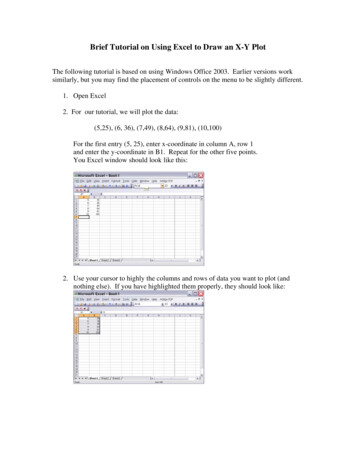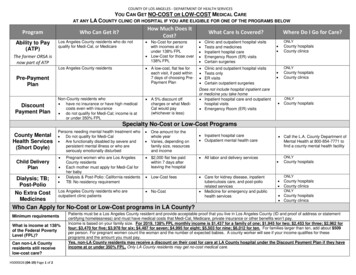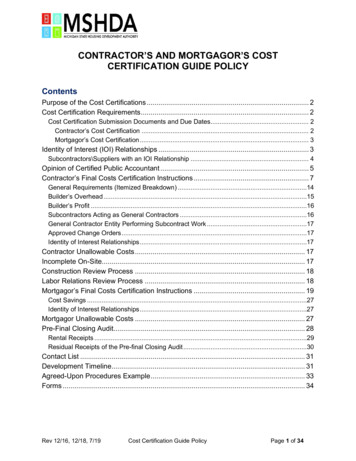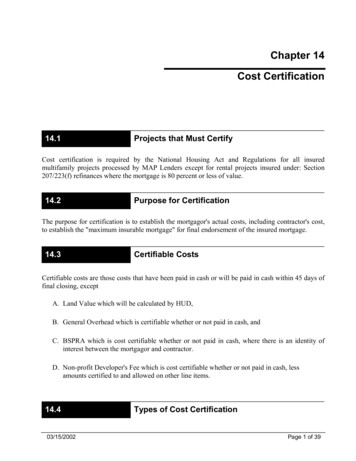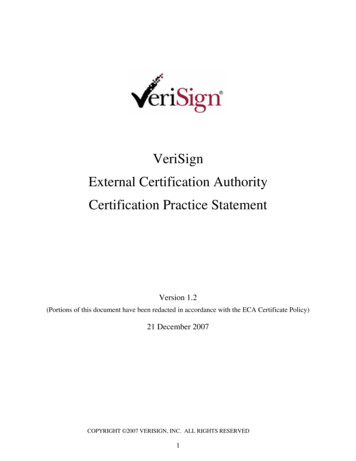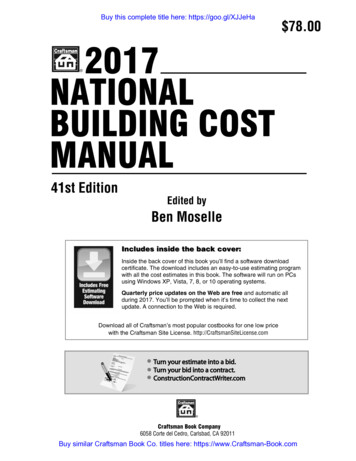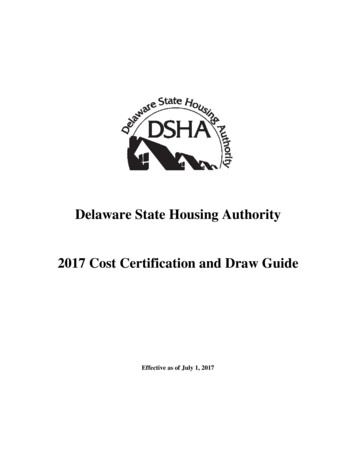
Transcription
Delaware State Housing Authority2017 Cost Certification and Draw GuideEffective as of July 1, 2017
TABLE OF CONTENTSFOREWORD . 2GENERAL DEFINITIONS. 3REQUIREMENTS PRIOR TO AND DURING CONSTRUCTION . 6CHANGE ORDER POLICY . 13General Information . 13Architect Responsibilities . 18Owner Responsibilities . 18Procedures . 19Change Order Examples . 20GENERAL CONTRACTOR INFORMATION . 23CONTRACTOR’S DRAW REQUISITION POLICIES . 26Contractor’s Draw Requisition Line Items . 29Contractor’s Draw Requisition Forms . 37MORTGAGOR’S DRAW REQUISITION POLICIES. 39Mortgagor’s Draw Requisition Line Items . 41Mortgagor’s Draw Requisition Forms . 50COST CERTIFICATION GUIDE . 52General. 52Eligible Mortgagor Costs . 57Eligible Contractor Costs . 61Additional Requirements . 64INSURANCE POLICY REQUIREMENTS . 66General Requirements . 66During The Construction Period . 67Permanent Insurance . 73Attachment A – 2017 Agency Fees . 77Attachment B – 10% Test . 78Attachment C – Contractor’s Draw Requisition Forms . 79Attachment D – Mortgagor’s Draw Requisition Forms. 80Attachment E – Contractor’s Cost Certification Forms . 81Attachment F – Mortgagor’s Cost Certification Forms . 82Attachment G – DSHA Minimum Construction Standards (2017) . 831
FOREWORDThe Delaware State Housing Authority (DSHA) is a state housing finance and housing credit agencyresponsible for the financing of low- to moderate-income housing development through the HousingDevelopment Fund (HDF), HOME Program, National Housing Trust Fund (NHTF), Affordable RentalHousing Program (ARHP), and the administration and allocation of Low Income Housing Tax Credits(LIHTC) for the State of Delaware.This publication was developed to provide mortgagors, contractors, and certified public accountants withinformation to assist in DSHA’s construction process and the preparation and submission of certificatesof actual cost after completion of a multi-family project prior to permanent closing of the mortgage loan.In addition, this manual is intended to be used as a guide for the LIHTC, HDF, HOME, NHTF, and/orARHP programs and to inform developers, contractors, and owners of the requirements implemented bythis agency to facilitate compliance with the state, federal, and IRS regulations. This manual is also aresource and procedural tool for housing developments in DSHA’s programs. This manual is not asubstitute for federal and state laws and regulations.Because of the complexity of the LIHTC regulations, HDF, HOME, NHTF, ARHP, and other statehousing programs, along with the necessity to consider the applicability to specific circumstances, ownersare urged to seek appropriate legal and accounting advice regarding cost certification and constructionissues.Independent Certified Public Accountants (ICPA) are required to contact DSHA prior to the startof the cost certification process to determine any abnormalities in the costs being certified that maynot be disclosed by standard audit procedures. In addition, we strongly recommend that engagementof the ICPA is completed prior to construction closing for periodical (quarterly) review of the draws andother information needed to perform the cost certification.The Developer and the General Contractor may engage an ICPA of their choice and can be differentICPAs.All questions concerning this Cost Certification Guide should be directed to Stephanie Griffin via e-mailat StephanieG@destatehousing.com or via phone at (302) 739-4263, or Jim Loescher via e-mail atJimL@destatehousing.com or via phone at (302) 739-4263, or by mail to the Delaware State HousingAuthority, 18 The Green, Dover, DE 19901.All Developer fee changes are effective 07/01/2017. Tax Credit Allocations and/or HDF/ARHP/HOMEloans made prior to 07/01/2017 will continue to use the previous fee schedule.2
GENERAL DEFINITIONSContract Price: The contract price for labor, materials, and necessary services after the deduction of allrebates, adjustments, discounts, promotional, or advertising allowances made or to be made to themortgagor, developer, any corporation, joint venture, partnership, or other legal entity in which any ofthem hold an interest in the project. All costs are subject to cost certification in accordance with thisGuide and the contract documents.Conversion Date: The date in which the construction debt is converted to permanent debt.Cost Certification Cut-Off Date: The cost certification cut-off date is the date to which the mortgagor ispermitted to attribute its costs for interest, taxes, and property and mortgage insurance premiums, if any,towards eligible basis costs. This date may be either (a) the last day of the month in which the early ofthe issuance of DSHA “Permission to Occupy” approval(s) on the last building, issuance of all TCOs, orissuance of all final COs occurs, (b) the last day of the month following the month in which the early ofthe issuance of DSHA “Permission to Occupy” approval(s) on the last building, issuance of all TCOs, orissuance of all final COs occurs, or (c) such other date as the ICPA may determine after consultation withDSHA. The date chosen as the cut-off date and the date to which the operating statement and balancesheet are computed must be the same unless otherwise approved or directed by DSHA.Identity of Interest: An identity of interest means any relationship, written or implied, that would givethe mortgagor, developer, consultant, or contractor control or influence over the prices paid tosubcontractors, equipment lessors, vendors, material suppliers, architect, attorney, engineer, surveyor,consultant, advisor, or any other individual or entity receiving compensation in connection with thedevelopment. The identity of interest relationship is usually created by a financial interest, but could beother means such as a familial relationship. An identity of interest shall be construed to exist under any ofthe following conditions:a. When there is any familial or financial interest of the mortgagor, developer, consultant, or thecontractor with any subcontractor, vendor, or material supplier or when the contractor uses its ownmaterials or employees to complete or perform a portion of the work required by the contractdocuments (other than charges attributable to the General Requirements);b. When one or more of the officers, directors, partners, or stockholders of the mortgagor, developer,consultant, or contractor is also an officer, director, partner, or stockholder of any subcontractor,vendor, material supplier, architect, attorney, engineer, surveyor, consultant, advisor, or any otherindividual or entity receiving compensation in connection with the development;c. When any officer, director, partner, or stockholder of the mortgagor, developer, consultant, orcontractor has any financial interest in any subcontractor, vendor, or material supplier;d. When any subcontractor, vendor, or material supplier advances any funds to the contractor ormortgagor;e. When any subcontractor, vendor, or material supplier provides and pays, on behalf of the mortgagor,developer, consultant, or contractor, the cost of any architectural services or engineering services orany other costs for which the subcontractor is not responsible under its subcontract;f. When any subcontractor, vendor, or material supplier takes stock or any interest in the mortgagor,developer, consultant, or contractor entity as part of the consideration to be paid;3
g. When there exists or comes into being any agreements, contracts, or undertakings entered into orcontemplated, thereby altering, amending, or canceling any of the required closing documents, exceptas approved by DSHA; andh. When there exists or comes into being any familial relationship between the officers, directors,stockholders, or partners of the mortgagor, developer, consultant, or contractor entity and officers,directors, stockholders, or partners or any subcontractor, vendor, or material supplier entities whichcould cause or results in control or influence over prices paid.Although somewhat synonymous with the term “Related Party” as defined by the AICPA in its Statementon Auditing Standards No. 18, DSHA’s definition of an identity of interest relationship is broader andmore inclusive. It is not anticipated that DSHA’s position concerning identities of interest will placeadditional burden or responsibility upon the ICPA; however, DSHA expects the accountant to be alert forrelationships which are or appear to be identities of interest as described above.If the Developer, member of the Development Team (inclusive of the General Contractor), and/orApplicant have related party and/or identity of interest subcontractor firms, they may not bid on theconstruction work or perform work on the development. If the General Contractor directly employs atrade, then the General Contractor may self-perform the work (i.e. if the General Contractor directlyemploys a licensed plumber, the GC may self-perform plumbing trades on the job). However, the GeneralContractor must obtain three competitive bids and cannot charge any more than the lowest bid.Mortgagor: The borrowing entity (typically the owner).Subcontractor: Shall include material and labor suppliers and equipment lessors.Substantial Completion: The time of substantial completion of the development in accordance with theConstruction Contract and architect approval. Substantial completion is typically defined as the date thatall parties acknowledge through written documentation that 100% of the units are completed and readyfor occupancy or the date of the certificate of occupancy for the last completed building, whichever isearlier.Total Equity Contribution: All LIHTC, Historic Tax Credit, energy, or solar tax credit equitycontributions made for the benefit of or to the development, including equity contributions used to fundthe construction hard costs, development soft costs, syndicator legal and accounting costs, tax creditmonitoring fee, tax credit allocation fee, operating reserve, transitional subsidy reserve, replacementreserve, and carpeting replacement reserve.a. All equity contributions made in excess of the Total Equity Contribution before or after theConversion Date will be:i.Allocated to the payment of DSHA loans in the order and priority set in the DSHA RegulatoryAgreement. If no such document exists, to development costs or development accounts asapproved by DSHA as the LIHTC allocating agency for the State of Delaware; orii.In the event there are insufficient funds to pay for eligible development costs (as determined byDSHA), and there are no other available monies in any of the funds, accounts, or reservesrelated to the development which have been previously approved for such use by DSHA and all4
other development secured lenders and such eligible development costs could otherwise only bepaid through the Developer’s Fee, then at the discretion of DSHA, such excess equitycontribution may be used to pay such eligible Development costs. Any equity contributionremaining after paying such eligible development costs must then be allocated to the paymentof the DSHA loans in the order and priority set forth in the DSHA Regulatory Agreement. If nosuch document exists, to development costs or accounts as approved by DSHA as the LIHTCallocating agency for the State of Delaware. In no case may the Developer’s Fee exceed theDeveloper Fee approved by DSHA.b. In the event the final equity contributions are less than the projected Total Equity Contribution, thensuch equity shortfall shall solely be the responsibility of the Developer. No monies in any of thefunds, accounts, or reserves related to the development may be used to pay any such shortfall.5
REQUIREMENTS PRIOR TO AND DURING CONSTRUCTIONThis section outlines the basic requirements during the underwriting and construction periods. DSHArecognizes that circumstances may vary from development to development depending on the size, scope,and financing arrangements, and will consider changes or variations as circumstances warrant. Allinformation will be reviewed in detail at DSHA’s pre-construction meeting, and will apply throughout theconstruction period. Please refer to the project’s preconstruction meeting minutes for more information.All LIHTC developments must adhere to DSHA’s underwriting criteria, minimum construction andrehabilitation standards, including DSHA’s construction process (draws, progress meetings, inspections,etc.), and cost certification process, regardless of financing source(s), including tax-exempt bondfinancing, DSHA amortized permanent financing, or LIHTC projects with no DSHA financing. All unitsin a development must receive the same upgrades/modifications or rehab work and be brought up to thesame standards. The developer is responsible for complying with DSHA's minimum construction andrehabilitation standards along with all rules, ordinances, and laws of all legal entities and authoritieshaving jurisdiction over the development, and the construction and/or alteration of the development,whether or not such requirements are specifically addressed in the plans and specifications or by DSHA'sreview.1. Architect Responsibilities: The architect is responsible for, and has complete oversight of, theproject and must be the lead entity on all construction issues during the construction phase. Thearchitect’s responsibilities include, but are not limited to, the following:a. Attend all draw and progress meetings;b. Record and distribute the minutes of those meetings to all parties (field reports should beincorporated in all minutes);c. Receive and approve all product submittals from the contractor. DSHA must approve anyproduct substitution;d. Establish a contractual relationship between the engineer(s) and surveyor and coordinate the workof the engineer(s), surveyor, or other sub-consultants;e. Determine which tests (i.e. compaction for footings, under slab, concrete) are required by theplans/specifications, and advise contractor (test results must be submitted to and reviewed byDSHA;f. Initiate all change orders 1 using DSHA’s standard format with signature lines for DSHA, thearchitect, owner, contractor, and all lenders (Note: field changes costing less than 2,500 that areemergencies, or are otherwise immediately required may be made prior to approval of a changeorder, but DSHA must be notified immediately of such changes, and a change order must beapproved for the work);1All material changes in the plans and specifications require a change order, regardless of the cost. DSHAwill not approve change orders where there is no record in the meeting minutes of the requested change or where thework was performed more than 90 days before the change order was received by DSHA. (See Change Order Policysection for more details). Incomplete change orders will be returned unprocessed and will require resubmission anda 250.00 administrative service fee for each document being reprocessed. The administrative fee is not an eligibleproject cost.6
g. Any code requirements that are missed, neglected, or were due to changes required by codeauthorities, can be considered for a change order as part of the project costs at the option ofDSHA. Costs above and beyond the customary charge if the work had been included in theoriginal scope (ex: opening a wall to install an additional necessary outlet) due to the error maynot be approved and will be the responsibility of the architect. DSHA reserves the right todetermine if approval of a change order is warranted and each request will be reviewed on a caseby-case basis; andh. Complete as-built drawings and coordinate information for engineer(s) or surveyor for the finalALTA survey due upon completion of the project.2. Construction Kick-off Meeting: A preconstruction kick-off meeting will be held at DSHA’s officeswithin 10 days of construction closing. The architect, developer, development consultant (ifapplicable), and contractor must attend. The meeting may also be coordinated to include engineers,lenders, or syndicators, and/or management company representatives.3. Notice to Proceed: The notice to proceed date will be determined at the preconstruction kick-offmeeting and issued by the architect. The notice must be issued no later than 30 days after constructionclosing, and a copy of the notice must be sent to all parties.4. Draw and Progress Meetings: DSHA requires that one progress and one draw meeting be held onsite each month. The dates and times of these meetings will be establ
of the cost certification process to determine any abnormalities in the costs being certified that may not be disclosed by standard audit procedures. In addition, we strongly recommend that engagement of the ICPA is completed prior to construction c



